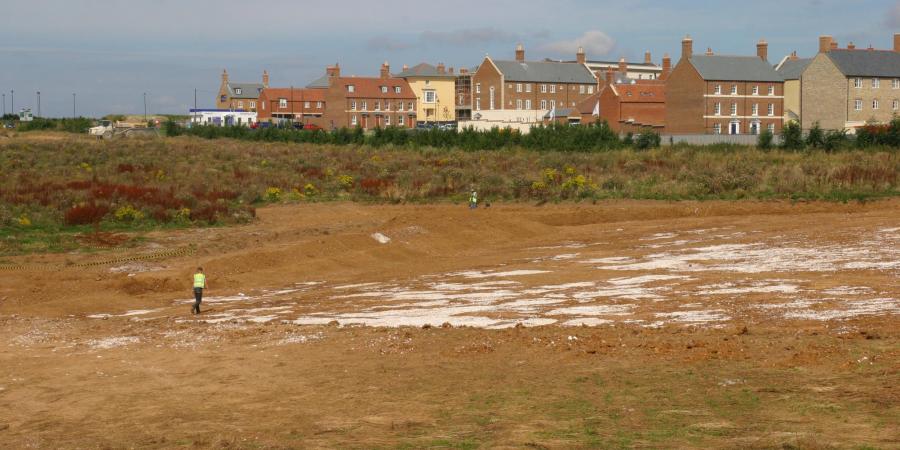Summary
Between 2006 and 2013, the Duchy of Cornwall commissioned Wessex Archaeology to undertake various archaeological investigations in advance of development at Poundbury Farm, Dorchester. The site is located within the rich archaeological landscape that encompasses the Dorset Downs, South Dorset Ridgeway and Frome Valley.

The investigations revealed a scattering of prehistoric finds, deposits and features including stray artefacts, land divisions, numerous pits (some with deliberately selected and deposited contents), a large ring-ditch monument and several mortuary-related features. There was a conspicuous lack of evidence for activity within the immediate vicinity during the Iron Age.
The abundant Romano-British features and material ranging from the early to late phases (1st to 5th century AD). These are largely related to a small farming settlement that relied heavily on sheep husbandry, and almost certainly supplied their wares to the nearby Roman town of Durnovaria (now Dorchester). Some of the inhabitants were involved in crafts and small-scale industry (eg, metal working) and processed their crops on site. Like their prehistoric predecessors, the small community chose to bury their dead relatively close-by. While most had adopted typically ‘Roman’ burial rites, some people or groups adjusted these to suit their own requirements; others opted to follow the local, traditional Durotrigian style of burial.
Later activity is hinted at by stray finds and the odd agricultural feature.
The Challenge
Fieldwork investigations commenced in 2006 with a 165 trial trench evaluation, the results of which (combined with other archaeological data from the locale), led to several targeted open area excavations, most of which were completed in 2007. In 2013 it became safe to access and excavate the final part of the site.
The fieldwork and subsequent analysis presented the usual challenges of most such projects, all of which (together with the commissioning body, monitors and subcontractors), were readily accepted and achieved by the Wessex Archaeology team.
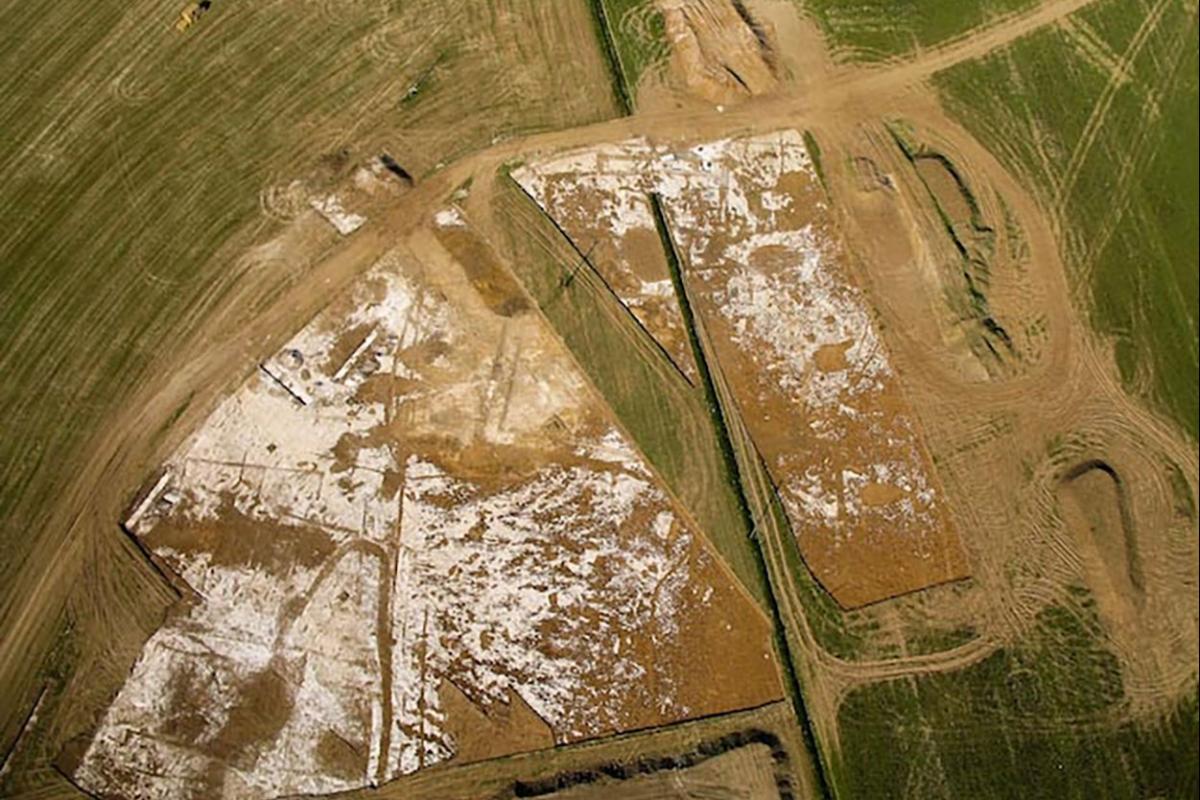
Aerial views of part of the site, showing the Romano-British enclosures and settlement area (courtesy of Aerialpics)
Our Approach
All aspects of the project were undertaken in consideration of Wessex Archaeology’s standard procedures and the industry standards and guidance as outlined by the Chartered Institute for Archaeologists (CIfA).
Our Results
Mesolithic (8500–4000 BC) and
Neolithic (4000–2200 BC)
A small assemblage of residual worked flint, including some bladelets and a possible burin, was found during the trial trench evaluation.
A number of isolated pits, clusters of pits and a few other features contained material of Neolithic date, such as pottery, worked flint, animal bone and hazelnut shells. Most from Poundbury Farm have been dated to the Early part of the period, ie, around 5000-6000 years ago. Particularly notable was the discovery of a substantial quantity of emmer wheat spikelets and naked barley grains from a large pit. A grain of barley was radiocarbon dated to 3770–3640 cal BC, indicating that the cultivation of these cereals was well-established, here, during the Early Neolithic. Because both types of crop would have been sown in the spring and require different processing methods, it is thought that the crops represent two different harvests. Accompanying weed seeds tell us that the crops are likely to have been gathered by uprooting or cutting the stalks low to the ground.
The discovery of a ‘cache’ of 11 flint axes (mostly rough-outs) and fragments relating to axe manufacture from the pits was particularly significant. WA’s Phil Harding discusses how these may compare with other ‘acts of deposition’ (eg, metal hoards) and how the new evidence has assisted in the understanding of flint axe production and distribution in the region, in Axes and Pits: Early Neolithic flint working at Poundbury Farm, Dorchester, Dorset in Lithics issue 31.
Near complete Early Neolithic flint axe from pit 3009
Beaker and Bronze Age (2400–1800 BC and 2200–700 BC)
A small quantity of pottery – recovered from one of two similar pits, each containing charcoal, charred hazelnut shells and fired clay – confirmed that people continued to use the site during the Beaker period.
Radiocarbon dating tells us that approximately 4000 years ago (ie, in the Early Bronze Age) a woman who had died in her thirties was buried next to a large, possibly contemporaneous, monument that included a large ring-ditch.
The small number of Middle Bronze Age (1600–1100 BC) cremation-related deposits found across the site included urned and unurned burial remains. The most interesting was an unusual example of a burial featuring two incomplete Deverel-Rimbury Bucket Urns, the first contained the cremated remains of two adult females and was placed upright within the grave. The second urn was placed upside-down over the first, completely encasing it.
One of the large pits had been re-used and re-cut over a long period of time; radiocarbon dating demonstrated that the thick layer of charred grain at the base had been deposited in the Middle/Late Bronze Age, while the pottery from the upper fills and later re-cuts suggests a Late Bronze Age date (1100–700 BC).
The Late Bronze Age inhabitants were increasingly transforming the landscape, dividing it into routeways, fields and other ‘special’ areas, and leaving more abundant evidence for settlement, farming and small-scale but varied crafts, such as textile production, leather and metal working. They, too, were burying their dead nearby – the crouched remains of an older adult male were found at the base of a large pit.


Left: Bronze Age ring-ditch and associated features (courtesy of Aerialpics). Right: Illustrations of the remains of an unusual Middle Bronze Age urned cremation burial
Iron Age (700 BC–AD 43)
Very little evidence of Iron Age activity was seen at Poundbury Farm, which fits with the current understanding that, at least during the early part of the period, people tended to live in and around the nearby hillforts at Poundbury Camp and Maiden Castle.
Romano-British (AD 43–410)
The Romano-British period saw the founding of the town of Durnovaria (Dorchester), which was soon to become an important administrative centre, surrounded and supplied by small farmsteads including the one discovered at Poundbury Farm.
The most prominent features on site are the large ditched enclosures, which had been established modified and added to throughout the period.
These enclosures mainly relate to agriculture, which, although largely concerned with sheep farming, included crop production and the keeping of cattle. The predominance of bones from older animals implies that they were mostly bred and kept for secondary products, such as wool and milk, and to provide traction as well as fertilise the soil. In the later part of the period, the inhabitants constructed and used a variety of driers to process their crops.

Plan showing the Romano-British activity
A cluster of semi-subterranean structural remains in the corner of one of the enclosures represent the main focus of habitation. The first of two masonry-walled examples housed two ovens, fuelled in part by cereal processing waste. Following its demolition, a smaller structure of comparable style and purpose was constructed in its place. The remains of a number of post-built structures were found nearby. Other ovens were also found on the site.
Working surfaces and quarries, and features containing evidence for antler and metal working, indicate a degree of small-scale craft and industry, which appears to have become more important to the inhabitants as the period progressed.

Romano-British crop drier and associated spread

Remains of Romano-British masonry-built semi-subterranean structures
In contrast to the large, formal Romano-British cemeteries just outside of the town walls (eg, Poundbury Camp), the Poundbury Farm community buried their dead along the sides of the enclosure ditches, away from the settlement and arranged either in small groups, as pairs, or alone. Infants and babies were, as is usually the case during this period, buried close to or within the settlement area.
In most cases the corpse had been laid out on their back, sometimes wearing hobnailed footwear and placed within a coffin. However, the more traditional, local style of burial (Durotrigian) was also popular, especially for women. Their remains, often accompanied by a pottery vessel or two, would be placed directly in the grave, lying on one side with the knees bent. A late Roman armlet from one such grave challenges the common belief that Durotrigian-style burials imply a Late Iron Age or early Roman date.
A number of the burials included complete lamb carcasses, an uncommon rite that might be linked to the community’s reliance on sheep farming, although they may also have been a symbolic reference to innocence and purity. One of these burials was of a child around 10 years of age, who, after their demise, had been decapitated as part of the mortuary ritual. While Roman decapitation burials are not unusual, examples in such a young individual are scarce.
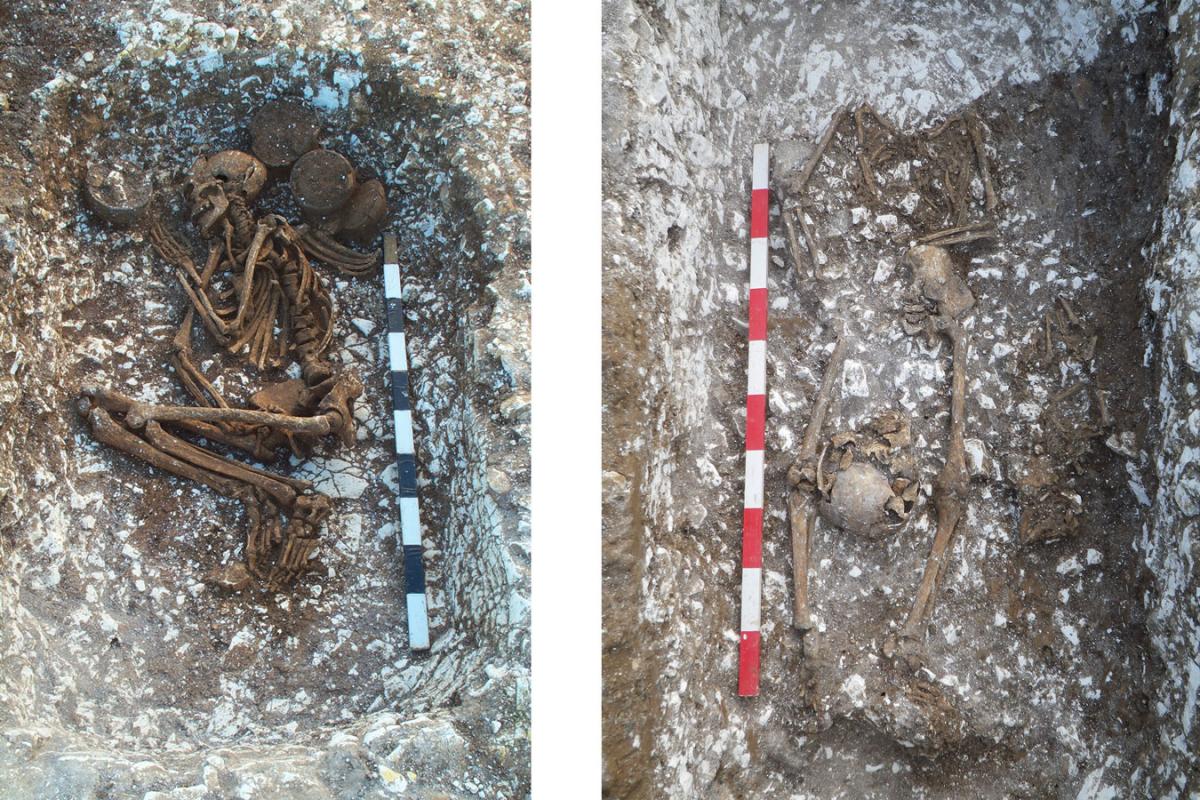
Left: Late Roman copper alloy snakeshead armlet from Durotrigian burial. Centre: Durotrigian style burial remains (early Romano-British adult female). Right: Remains of a Romano-British decapitation burial of a juvenile, accompanied by a lamb (along the side)
Whilst stone coffins – a clear demonstration of high status – have been found within the large town cemetery at Poundbury Camp, no others had been found within the rural surrounds, so it is of some note that one was discovered at Poundbury Farm. The coffin was made in two parts of relatively local cornbrash and held the remains of an adult possible male. It is clear that the stone coffin had been opened following its burial, as, despite the lid being in situ, the coffin was completely filled with soil. The ground above it showed signs of disturbance and contained a late-18th century button, pointing to a visit from an antiquarian.
A beautiful late 2nd to early 3rd century enamelled silver disc brooch from one of the enclosure ditches provides another high status link to the settlement.

Left: Romano-British stone coffin in situ. Right: Enamelled silver disc brooch from Romano-British enclosure ditch
The remains of the Romano-British urned cremation burial is remarkable for two reasons, the first being that the cinerary vessel – a Black-Burnished ware jar – indicates a later date than would normally be expected. Secondly, and currently uniquely, the jar was still sealed by a clay plug and capped by a flat piece of flint when it was excavated.
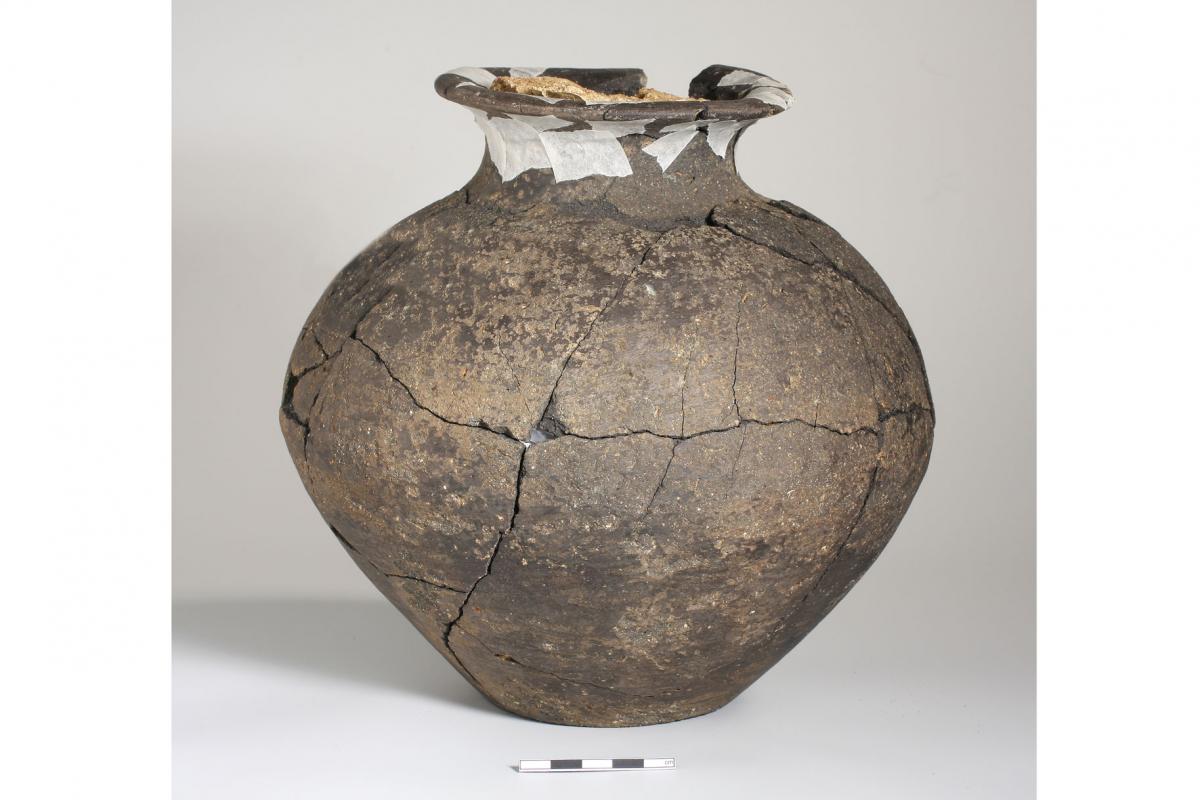
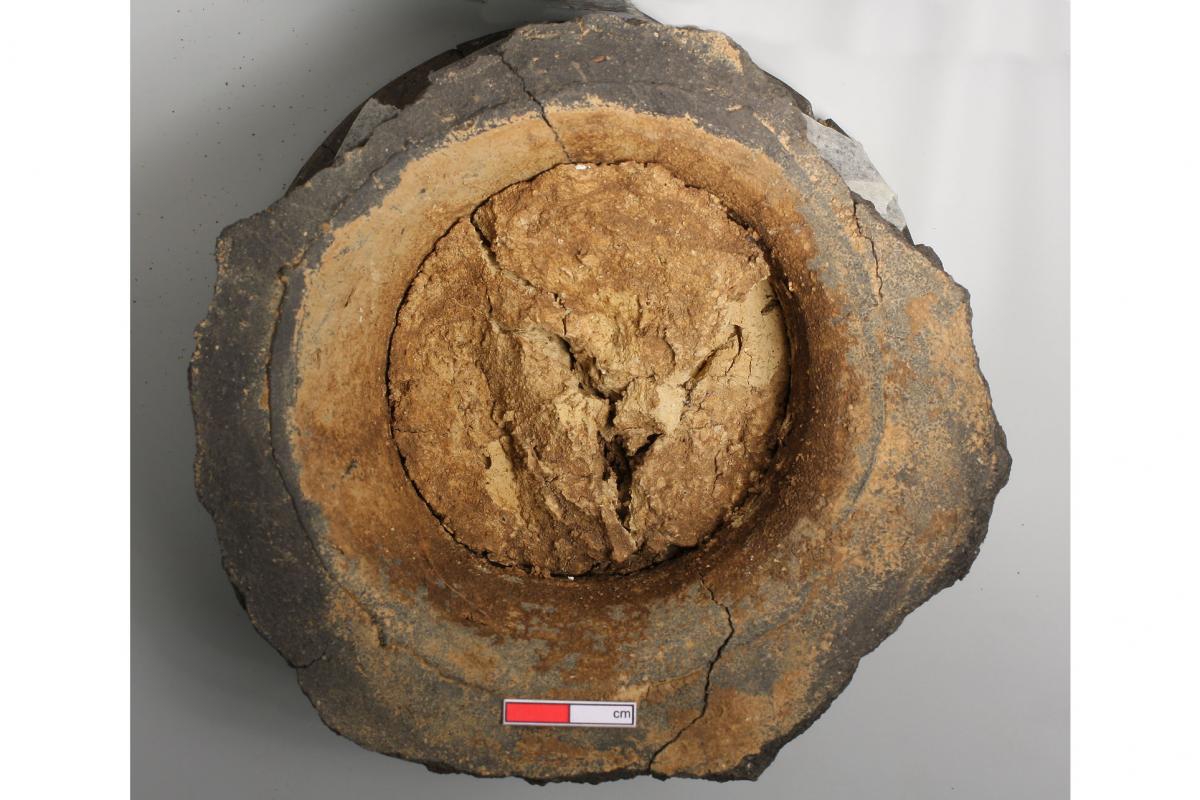
Romano-British cremation urn with intact clay plug
Post-Roman and later activity
Later activity is represented by a single sherd of possibly early Saxon pottery, and another of medieval date. A few shallow lynchets of probable medieval origin were excavated along the northern and western slopes of the site. The post-medieval artefacts, found in some abundance within the topsoil, most likely relate to the use of waste to manure the fields.
Discussion
The excavations at Poundbury and subsequent analysis of the findings have allowed insights into the changing ways of life for those who inhabited the area around what is now Dorchester, from late prehistory onwards.
The evidence demonstrates how people used and adapted the landscape, marked out special places and chose where to settle. It shows how these influenced later communities, who in turn modified the land for their own needs. The mortuary-related remains have demonstrated shifting (as well as enduring) traditions and rites, and have provided new insights into the ways in which the various groups of people lived and worked, and dealt with death and grief.
For the results of the 2007 excavations, see our monograph publication Prehistoric Activity and a Romano-British Settlement at Poundbury Farm, Dorchester, Dorset
For the 2013 excavation results, read Further Prehistoric and Romano-British activity at Poundbury Farm, Dorchester, Dorset or an abridged version in the Proceedings of the Dorset Natural History and Archaeological Society.
More images are available on our Flickr page.
